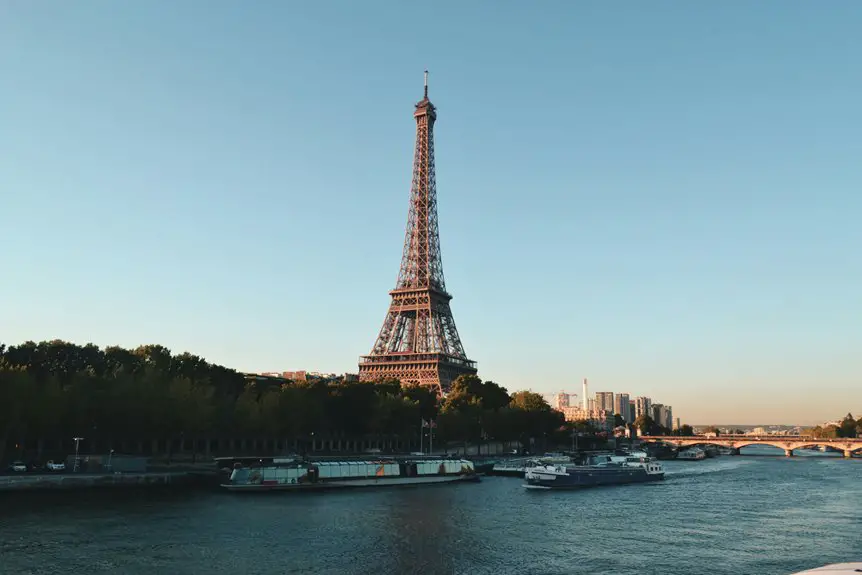You’ll find that “La Grande Boucle,” meaning “The Great Loop,” perfectly captures the Tour de France’s epic circular route through France’s varied landscapes. This nickname reflects the race’s rich history, challenging terrain, and deep cultural ties to French heritage. It’s been shaped by evolving courses and media that have made it iconic worldwide. If you keep exploring, you’ll discover how this legendary loop connects communities, fans, and the spirit of competition like no other race can.
Table of Contents
Key Takeaways
- “La Grande Boucle” means “The Great Loop,” highlighting the Tour de France’s iconic circular route through diverse French landscapes.
- The nickname originated from early enthusiasts admiring the race’s unique, challenging loop format established in 1903.
- It symbolizes French national pride and cultural heritage by connecting historic towns and communities across varied terrains.
- Media and commercial use have popularized the nickname globally, linking it to the Tour’s prestige and toughness.
- Future race innovations aim to preserve the nickname’s essence while enhancing fan engagement through advanced technology and immersive experiences.
Historical Origins of “La Grande Boucle”
Although you might know the Tour de France simply by its official name, “La Grande Boucle” has long served as a beloved nickname. You’ll find that this phrase, meaning “The Great Loop,” perfectly captures the race’s essence—a challenging, circular journey through France.
The nickname dates back to early cycling enthusiasts who admired the race’s demanding course and its grand scale. When the Tour first began in 1903, riders completed a loop around the country, which was unusual and ambitious at the time.
People started calling it “La Grande Boucle” to highlight the race’s unique format and epic scope. So, when you hear that nickname, you’re tapping into over a century of history celebrating the race’s distinctive looped route and enduring challenge.
Geographic Significance of the Tour’s Route
The nickname “La Grande Boucle” highlights the Tour de France’s iconic circular route, but the race’s geographic layout offers more than just a loop.
As you follow the race, you’ll witness France’s diverse landscapes—from the coastal plains to the rugged Alps and Pyrenees mountains. This variety not only tests riders’ endurance but also showcases the country’s cultural and natural richness.
You’ll see how the route strategically crosses key regions, connecting historic towns and modern cities, creating a vivid tapestry of French heritage. The course challenges cyclists with varying altitudes and terrain, demanding adaptability and skill.
The Evolution of the Tour De France Course
You’ve probably noticed how the Tour De France course has shifted over the decades, changing its routes and challenges.
These changes force riders to adapt their strategies constantly to stay competitive.
Let’s explore how these evolving routes impact the race dynamics and rider tactics.
Route Changes Over Decades
As the decades have passed, the Tour de France has continuously adapted its route to challenge riders and captivate fans. You’ll notice how the course has evolved, balancing flat sprints with grueling mountain stages. Organizers tweak routes to showcase different French regions and keep the race unpredictable. Here’s a glimpse of how the route changed over time:
| Decade | Route Highlights |
|---|---|
| 1900s | Mostly flat, long stages |
| 1930s | Introduction of mountain climbs |
| 1960s | Time trials gain prominence |
| 1990s | More alpine stages added |
| 2020s | Diverse terrain, mixed stages |
Impact on Rider Strategies
Route changes in the Tour de France don’t just shape the race scenery—they directly influence how riders plan and execute their strategies.
As the course evolves, you’ll need to adapt your approach, keeping these key impacts in mind:
- Energy Management: Longer mountain stages demand careful pacing to conserve stamina for critical climbs and finishes.
- Team Roles: Flat stages favor sprinters, so you’ll rely more on domestiques to control the peloton and set up sprints.
- Tactical Flexibility: Varied terrain forces you to switch tactics quickly, whether attacking in the Alps or defending time on rolling hills.
Understanding these strategic shifts helps you stay competitive, making the nickname “A Grande Boucle” truly fitting for the ever-changing challenge you face.
Cultural Impact of the Nickname in France
Although the nickname “La Grande Boucle” may seem simple, it carries deep cultural significance across France. You’ll notice it symbolizes more than just the race; it reflects national pride, unity, and a celebration of French landscapes. When you hear the term, it evokes images of challenging routes winding through iconic regions, connecting communities in a shared experience. The nickname anchors the Tour in French heritage, allowing you to appreciate the event beyond sport.
| Aspect | Cultural Meaning | Your Experience |
|---|---|---|
| National Identity | Symbol of French unity | Pride during race days |
| Regional Connection | Highlights diverse regions | Discovering local culture |
| Tradition | Deep-rooted history | Feeling part of legacy |
| Community Spirit | Shared celebration | Joining communal events |
| Language | French linguistic charm | Embracing local terms |
How “La Grande Boucle” Reflects the Race’s Challenge
Endurance defines “La Grande Boucle,” capturing the grueling nature of the Tour de France. When you hear this nickname, you immediately sense the immense challenge riders face throughout the race. It’s not just a loop on a map—it’s a test of physical and mental strength over diverse and punishing terrain.
Here’s how “La Grande Boucle” reflects the race’s challenge:
- Length and Duration – Covering around 3,500 kilometers in three weeks pushes your stamina to the limit.
- Varied Terrain – From flat sprints to brutal mountain climbs, it demands versatility and resilience.
- Unpredictable Conditions – Weather shifts and tactical battles add layers of complexity you must navigate.
This nickname perfectly symbolizes the monumental effort required to complete the Tour.
Media and Popular Usage of the Nickname
You’ve probably noticed how “La Grande Boucle” pops up more in media coverage as the Tour de France gains global attention.
This nickname isn’t just for fans in France—it’s become a part of popular culture worldwide.
Let’s explore how its usage has evolved and influenced the race’s cultural impact.
Media Coverage Evolution
Since its early days, the media has played a crucial role in popularizing the nickname “La Grande Boucle” for the Tour de France.
As coverage evolved, you’ve seen the nickname spread beyond print into various platforms, shaping public perception. Here’s how media coverage evolved:
- Print Media: Newspapers and magazines first embraced “La Grande Boucle,” using it to capture readers’ imagination and emphasize the race’s epic nature.
- Radio and Television: Broadcasts brought the nickname to life, making it familiar to millions who followed live race commentary and highlights.
- Digital and Social Media: Today, online platforms and social networks amplify the nickname instantly, creating a global community of fans who keep the term alive and relevant.
Understanding this evolution helps you appreciate how “La Grande Boucle” remains deeply embedded in Tour de France culture.
Cultural Impact Worldwide
Although the Tour de France is rooted in French tradition, its nickname “La Grande Boucle” has gained recognition far beyond France’s borders.
When you follow international cycling media or sports broadcasts, you’ll often hear commentators and journalists use this term, highlighting the race’s prestige. It’s become a shorthand that conveys respect for the event’s history and difficulty.
You’ll also notice that major sports networks across Europe and beyond embrace the nickname, reinforcing its global appeal.
If you pay attention to cycling forums and social media discussions, fans worldwide adopt “La Grande Boucle” to express their admiration.
This shared language helps connect you with a global community passionate about the race, underscoring how the nickname transcends its French origins to become a symbol of cycling excellence everywhere.
Usage in Popular Culture
When you tune into films, documentaries, or even commercials featuring cycling, “La Grande Boucle” often pops up as a powerful symbol of endurance and tradition.
You’ll see this nickname used to evoke the spirit of the Tour de France, connecting audiences to its rich history.
Here’s how it appears in popular culture:
- Documentaries and Films: Directors use “La Grande Boucle” to highlight the race’s grueling nature and cultural significance.
- Advertisements: Brands associate their products with the toughness and prestige of the Tour by referencing this nickname.
- Literature and Music: Writers and musicians mention it to capture the drama and excitement surrounding the event.
The Future of the Tour and Its Iconic Loop
As the Tour de France continues to captivate millions, its future promises exciting innovations while honoring the iconic Grande Boucle loop that defines the race. You’ll see technology enhancing rider safety and fan engagement without changing the race’s soul. The route may evolve, but the spirit of the loop remains intact, blending tradition with modernity.
Here’s what you can expect:
| Aspect | Future Outlook |
|---|---|
| Route Design | Balanced between classic and new |
| Technology | Advanced tracking and safety |
| Fan Experience | Immersive digital interactions |
Frequently Asked Questions
Who First Coined the Nickname “La Grande Boucle”?
You won’t find a single person who first coined “La Grande Boucle” because it emerged gradually. Journalists and fans started using it over time to capture the Tour de France’s epic, looping nature and prestige.
Does “La Grande Boucle” Have Any Official Status in Tour Branding?
Think of “La Grande Boucle” as the Tour’s whispered legend, not its official emblem. You won’t see it on banners or jerseys, but riders and fans embrace it, symbolizing cycling’s grandest loop of glory and endurance.
Are There Other Nicknames Commonly Used for the Tour De France?
You’ll often hear “Le Tour” as a popular nickname for the Tour de France. Fans and commentators use it casually, reflecting the race’s prestige without needing formal branding or elaborate titles.
How Do Non-French Speakers Refer to “La Grande Boucle”?
You’ll often hear non-French speakers simply call it the Tour de France. Some might say “the big loop” or “the great tour,” but most stick with the original name out of respect and recognition.
Has the Nickname Influenced Merchandise or Fan Culture Globally?
You’ll find “La Grande Boucle” inspiring unique merchandise and fan gear worldwide. It adds a touch of prestige and French flair, helping you connect deeper with the race’s heritage and global cycling community.
- The Use of Nonwovens in Construction and Civil Engineering - July 11, 2025
- The Use of Nonwovens in Construction and Civil Engineering - July 11, 2025
- The Use of Nonwovens in Construction and Civil Engineering - July 11, 2025







